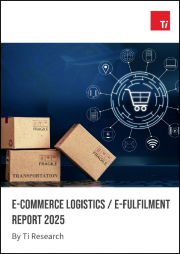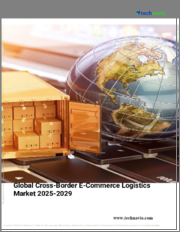
|
시장보고서
상품코드
1764755
크로스보더 E-Commerce 물류 시장(2025-2032년) : 서비스 유형별, 최종 용도별, 배송 유형별, 지역별 규모, 점유율 및 성장 분석과 예측Cross-Border E-Commerce Logistics Market Size, Share, and Growth Analysis, By Service Type, By End Use, By Delivery Type, By Region - Industry Forecast 2025-2032 |
||||||
크로스보더 E-Commerce 물류 세계 시장 규모는 2023년에 1,103억 달러로 평가되었고, 2024년의 1,363억 3,000만 달러에서 2032년에는 7,425억 8,000만 달러로 성장할 것으로 예상되며 예측기간(2025-2032년) 동안 CAGR은 23.6%로 전망하고 있습니다.
세계의 크로스보더 전자상거래 물류 시장은 전자상거래 수요 증가, 속도와 투명성에 대한 고객의 기대 증가, 유리한 무역 정책 등에 힘입어 강력한 성장을 이루고 있습니다. 이는 제품에 대한 액세스를 간소화하고 첨단 물류 솔루션의 필요성을 가속화하고 있습니다. 또한 배송 추적 및 통관 자동화 등의 기술 혁신을 채용하여 거래를 안전하게 수행할 수 있습니다. 이러한 디지털 전환은 보다 스마트하고 민첩한 크로스보더 물류 환경을 촉진하여 궁극적으로 전자상거래 기업과 세계 고객에게 이익을 제공합니다.
목차
소개
- 조사 목적
- 조사 범위
- 정의
조사 방법
- 정보 수집
- 2차 및 1차 데이터 방법
- 시장 규모 예측
- 시장의 전제조건과 제한
주요 요약
- 세계 시장 전망
- 공급과 수요 동향 분석
- 부문별 기회 분석
시장 역학과 전망
- 시장 개요
- 시장 규모
- 시장 역학
- 성장 촉진요인과 기회
- 억제요인과 과제
- Porter's Five Forces 분석
주요 시장 인사이트
- 주요 성공요인
- 경쟁도
- 주요 투자 기회
- 시장 생태계
- 시장의 매력 지수(2024년)
- PESTEL 분석
- 거시경제지표
- 밸류체인 분석
- 가격 분석
- 기술 분석
- 사례 연구
- 고객 구매행동 분석
크로스보더 E-Commerce 물류 시장 규모 : 서비스 유형별&CAGR(2025-2032년)
- 시장 개요
- 크로스보더 화물 수송
- 국제 운송 관리 및 화물 운송
- 국제 창고 및 물류
크로스보더 E-Commerce 물류 시장 규모 : 최종 용도별&CAGR(2025-2032년)
- 시장 개요
- 제조업과 자동차
- 석유 및 가스
- 화학 약품
- 농업
- 어업과 임업
- 건설
- 유통 무역
- 의약품 및 헬스케어
- 기타
크로스보더 E-Commerce 물류 시장 규모 : 배송 유형별&CAGR(2025-2032년)
- 시장 개요
- 표준 배송
- 당일 배송
크로스보더 E-Commerce 물류 시장 규모 : 지역별&CAGR(2025-2032년)
- 북미
- 미국
- 캐나다
- 유럽
- 독일
- 스페인
- 프랑스
- 영국
- 이탈리아
- 기타 유럽
- 아시아태평양
- 중국
- 인도
- 일본
- 한국
- 기타 아시아태평양
- 라틴아메리카
- 브라질
- 기타 라틴아메리카
- 중동 및 아프리카
- GCC 국가
- 남아프리카
- 기타 중동 및 아프리카
경쟁 정보
- 상위 5개사 비교
- 주요 기업의 시장 포지셔닝(2024년)
- 주요 시장 기업이 채용한 전략
- 최근 시장 동향
- 기업의 시장 점유율 분석(2024년)
- 주요 기업의 기업 프로파일
- 기업의 상세
- 제품 포트폴리오 분석
- 기업의 부문별 점유율 분석
- 전년 대비 수익 비교(2022-2024년)
주요 기업 프로파일
- Agility Public Warehousing Co. KSCP
- Alibaba Group Holding Ltd.
- Amazon.com Inc.
- AP Moller Maersk AS
- CH Robinson Worldwide Inc.
- CMA CGM Group
- ContextLogic Inc.
- Deutsche Post AG
- DSV AS
- eBay Inc.
- FedEx Corp.
- GXO Logistics Inc.
- JD.com Inc.
- Kuehne Nagel Management AG
- SF Express Co. Ltd.
- Singapore Post Ltd.
- United Parcel Service Inc.
- XPO Inc.
결론과 권고
CSM 25.07.15Global Cross-Border E-Commerce Logistics Market size was valued at USD 110.3 billion in 2023 and is poised to grow from USD 136.33 billion in 2024 to USD 742.58 billion by 2032, growing at a CAGR of 23.6% during the forecast period (2025-2032).
The global cross border e-commerce logistics market is witnessing robust growth, propelled by increasing demand for e-commerce, heightened customer expectations for speed and transparency, and favorable trade regulations. The proliferation of the internet and smartphones has simplified access to international goods, driving the need for advanced logistics solutions. Key players, like DHL, are embracing technology innovations such as AI-driven tracking and customs automation to enhance delivery transparency and streamline processes, significantly reducing customs clearance times. The adoption of AI, machine learning, IoT, augmented reality, and blockchain is revolutionizing logistics operations, enabling companies to predict consumer behavior, optimize inventory, and secure transactions. This digital transformation fosters a smarter, more agile cross-border logistics environment, ultimately benefiting e-commerce enterprises and their global clientele.
Top-down and bottom-up approaches were used to estimate and validate the size of the Global Cross-Border E-Commerce Logistics market and to estimate the size of various other dependent submarkets. The research methodology used to estimate the market size includes the following details: The key players in the market were identified through secondary research, and their market shares in the respective regions were determined through primary and secondary research. This entire procedure includes the study of the annual and financial reports of the top market players and extensive interviews for key insights from industry leaders such as CEOs, VPs, directors, and marketing executives. All percentage shares split, and breakdowns were determined using secondary sources and verified through Primary sources. All possible parameters that affect the markets covered in this research study have been accounted for, viewed in extensive detail, verified through primary research, and analyzed to get the final quantitative and qualitative data.
Global Cross-Border E-Commerce Logistics Market Segments Analysis
Global Cross-Border E-Commerce Logistics Market is segmented by Service Type, End Use, Delivery Type and region. Based on Service Type, the market is segmented into Cross-border Freight Transport, International Transportation Management & Freight Forwarding and International Warehousing & Logistics. Based on End Use, the market is segmented into Manufacturing & Automotive, Oil & Gas, Chemicals, Agriculture, Fishing & Forestry, Construction, Distributive Trade, Pharmaceutical & healthcare and Others. Based on Delivery Type, the market is segmented into Standard Delivery and Same-day Delivery. Based on region, the market is segmented into North America, Europe, Asia Pacific, Latin America and Middle East & Africa.
Driver of the Global Cross-Border E-Commerce Logistics Market
The rapid growth of e-commerce is a primary catalyst fueling the expansion of the global cross-border e-commerce logistics market. As online shopping becomes increasingly popular among consumers, businesses are keen to broaden their international reach to capitalize on this trend. This surge in online shopping has led to a heightened demand for international shipping services, emphasizing the necessity for efficient cross-border logistics solutions. To ensure timely deliveries across borders, companies require cost-effective distribution mechanisms. Moreover, advancements in payment systems and digital platforms facilitate smoother international financial transactions, which further contribute to the growth of the e-commerce logistics market on a global scale.
Restraints in the Global Cross-Border E-Commerce Logistics Market
The Global Cross-Border E-Commerce Logistics market faces significant challenges due to the varying regulations established by different countries concerning import and export allowances, taxation processes, and delivery service protocols. This disparity in rules can hinder companies' ability to ensure timely and efficient delivery services without incurring extra costs. Failure to comply with these regulations may lead to delays, fines, and the risk of lost shipments. Consequently, the intricate regulatory framework adds operational difficulties for logistics providers, resulting in increased overall operational expenses that can impede market growth and efficiency.
Market Trends of the Global Cross-Border E-Commerce Logistics Market
The Global Cross-Border E-Commerce Logistics market is witnessing significant growth trends fueled by rising population demographics, urbanization, and increasing disposable incomes, particularly in emerging economies. As urban centers expand, consumer demand for goods surges, prompting businesses to leverage online platforms for international trade. This shift opens new territorial markets, enabling brands to cater to the burgeoning middle-class population seeking diverse products. Moreover, with enhanced income levels, consumer spending on goods increases, facilitating seamless cross-border transactions. Consequently, the logistics sector is evolving to accommodate the complexities of international trade, underscoring the vital role of efficient cross-border logistics solutions in meeting this burgeoning demand.
Table of Contents
Introduction
- Objectives of the Study
- Scope of the Report
- Definitions
Research Methodology
- Information Procurement
- Secondary & Primary Data Methods
- Market Size Estimation
- Market Assumptions & Limitations
Executive Summary
- Global Market Outlook
- Supply & Demand Trend Analysis
- Segmental Opportunity Analysis
Market Dynamics & Outlook
- Market Overview
- Market Size
- Market Dynamics
- Drivers & Opportunities
- Restraints & Challenges
- Porters Analysis
- Competitive rivalry
- Threat of substitute
- Bargaining power of buyers
- Threat of new entrants
- Bargaining power of suppliers
Key Market Insights
- Key Success Factors
- Degree of Competition
- Top Investment Pockets
- Market Ecosystem
- Market Attractiveness Index, 2024
- PESTEL Analysis
- Macro-Economic Indicators
- Value Chain Analysis
- Pricing Analysis
- Technology Analysis
- Case Studies
- Customer Buying Behavior Analysis
Global Cross-Border E-Commerce Logistics Market Size by Service Type & CAGR (2025-2032)
- Market Overview
- Cross-border Freight Transport
- International Transportation Management & Freight Forwarding
- International Warehousing & Logistics
Global Cross-Border E-Commerce Logistics Market Size by End Use & CAGR (2025-2032)
- Market Overview
- Manufacturing & Automotive
- Oil & Gas
- Chemicals
- Agriculture
- Fishing & Forestry
- Construction
- Distributive Trade
- Pharmaceutical & healthcare
- Others
Global Cross-Border E-Commerce Logistics Market Size by Delivery Type & CAGR (2025-2032)
- Market Overview
- Standard Delivery
- Same-day Delivery
Global Cross-Border E-Commerce Logistics Market Size & CAGR (2025-2032)
- North America (Service Type, End Use, Delivery Type)
- US
- Canada
- Europe (Service Type, End Use, Delivery Type)
- Germany
- Spain
- France
- UK
- Italy
- Rest of Europe
- Asia Pacific (Service Type, End Use, Delivery Type)
- China
- India
- Japan
- South Korea
- Rest of Asia-Pacific
- Latin America (Service Type, End Use, Delivery Type)
- Brazil
- Rest of Latin America
- Middle East & Africa (Service Type, End Use, Delivery Type)
- GCC Countries
- South Africa
- Rest of Middle East & Africa
Competitive Intelligence
- Top 5 Player Comparison
- Market Positioning of Key Players, 2024
- Strategies Adopted by Key Market Players
- Recent Developments in the Market
- Company Market Share Analysis, 2024
- Company Profiles of All Key Players
- Company Details
- Product Portfolio Analysis
- Company's Segmental Share Analysis
- Revenue Y-O-Y Comparison (2022-2024)
Key Company Profiles
- Agility Public Warehousing Co. K.S.C.P
- Company Overview
- Business Segment Overview
- Financial Updates
- Key Developments
- Alibaba Group Holding Ltd.
- Company Overview
- Business Segment Overview
- Financial Updates
- Key Developments
- Amazon.com Inc.
- Company Overview
- Business Segment Overview
- Financial Updates
- Key Developments
- AP Moller Maersk AS
- Company Overview
- Business Segment Overview
- Financial Updates
- Key Developments
- C H Robinson Worldwide Inc.
- Company Overview
- Business Segment Overview
- Financial Updates
- Key Developments
- CMA CGM Group
- Company Overview
- Business Segment Overview
- Financial Updates
- Key Developments
- ContextLogic Inc.
- Company Overview
- Business Segment Overview
- Financial Updates
- Key Developments
- Deutsche Post AG
- Company Overview
- Business Segment Overview
- Financial Updates
- Key Developments
- DSV AS
- Company Overview
- Business Segment Overview
- Financial Updates
- Key Developments
- eBay Inc.
- Company Overview
- Business Segment Overview
- Financial Updates
- Key Developments
- FedEx Corp.
- Company Overview
- Business Segment Overview
- Financial Updates
- Key Developments
- GXO Logistics Inc.
- Company Overview
- Business Segment Overview
- Financial Updates
- Key Developments
- JD.com Inc.
- Company Overview
- Business Segment Overview
- Financial Updates
- Key Developments
- Kuehne Nagel Management AG
- Company Overview
- Business Segment Overview
- Financial Updates
- Key Developments
- SF Express Co. Ltd.
- Company Overview
- Business Segment Overview
- Financial Updates
- Key Developments
- Singapore Post Ltd.
- Company Overview
- Business Segment Overview
- Financial Updates
- Key Developments
- United Parcel Service Inc.
- Company Overview
- Business Segment Overview
- Financial Updates
- Key Developments
- XPO Inc.
- Company Overview
- Business Segment Overview
- Financial Updates
- Key Developments



















